Research Article - Der Pharma Chemica ( 2018) Volume 10, Issue 1
Revealing the J-coupling in the 1H-NMR Spectra of Antineoplastic and Antimetabolites Drugs
Sukhbir Singh Rattan1,2 and Pankaj Taneja2*
1Scube Scientific Software Solutions (P) Ltd., 1217 Hemkunt Chambers, 89 Nehru Place, New Delhi, India
2Department of Biotechnology, School of Engineering and Technology, Sharda University, Greater Noida, Gautam Budh Nagar, India
- *Corresponding Author:
- Pankaj Taneja
Department of Biotechnology
School of Engineering and Technology
Sharda University
Greater Noida, Gautam Budh Nagar, India
Abstract
Pyrimidines have a long and distinguished history extending from the days of their discovery as important constituents of nucleic acids to their current use in the chemotherapy of cancer. This heterocyclic moiety has great biological and medicinal significance. There are 12 compounds in PubChem database which come in a category of antimetabolites and antineoplastic, and follow the Lipinski rule of five. Since, PubChem have no spectral information of any compound, we examined the theoretical 1H spectral of these categorized compounds and described the relevance of pyrimidine ring and presence of J-J coupling in the structure of these drug compounds.
Keywords
Pyrimidine, NMR, J-coupling
Introduction
Nuclear Magnetic Resonance (NMR) spectroscopy has recently enjoyed an exceptional development (Magnets with increased field strength, shielded magnets, cryogenic probes, etc,) [1,2]. In the beginning, NMR in the pharmaceutical industry was mainly used as an analytical tool to validate and identify compounds that were synthesized by medicinal chemists. However, in the last few years NMR has obtained a central role in drug discovery and design. It is used in screening for the identification of lead structures, optimization of lead-target complexes, identifying the structure of target protein, DNA or RNA and elucidating reaction mechanisms [2]. During the last few decades enormous work has been focused on elucidating the mechanism of drug action in order to improve efficacy and reduce side effects. NMR spectroscopy has been applied as the principal method in the study of anticancer drugs.
Compounds in solution produce NMR spectral signals broadened by the effects of conformational heterogeneity and restricted molecular motion. The NMR data used as geometric restraints in structure determination relies predominantly on observed 1H-1H connectivity through space and through scalar couplings. J-coupling (Dipole-dipole coupling) is an indirect scalar interaction between two nuclear spin which arises from hyperfine interactions between the nucleus and local electrons [3]. It is now well established that the H-bond J-couplings follow the same electron-mediated polarization mechanism as their covalent counterparts [4]. J-couplings provide information about bond distance and angles and most importantly the connectivity of molecules in compounds.
Several antineoplastic compounds have been investigated in a search for selective effects on the utilization of pyrimidine precursors for the synthesis of nucleic acid pyrimidines [5,6]. Previous studies with the human cell lines and tumor transplants suggested that these compounds prevent or inhibit the maturation and proliferation of neoplasm [7]. Antimetabolites are compounds that inhibit the use of a metabolite which interfere with DNA production and consequently, cell division and the growth of tumors [8]. Many nucleoside or nucleobases analogues from this group were found to be effective cytostatic, for example, 6-mercaptopurine used for the acute lymphoblastic leukemia and 5-fluorouracil used for the treatment of colorectal, gastric, skin, breast and pancreatic cancer [9-11]. In this study, virtual 1H-NMR spectra were generated to reveal JH-H coupling in 12 anticancer agents. These compounds selected from PubChem Database strictly follow the Lipinski rule of five. The result presented suggests that deceptively complex spectra appear to be surprisingly general and should be considered when predicting the orientation of anticancer compounds.
Materials and Methods
Anticancer drugs
A total of 12 anticancer compounds that followed Lipinski rule of five and comes under the categories of antimetabolites and antineoplastic in PubChem database (http://pubchem.ncbi.nlm.nih.gov/) were selected.
1H-NMR spectrum of each compound was generated using the Mestrelab Research-Mnova software (v 8.1.1) (http://mestrelab.com/) [12]. Once spectra were predicted, automated peaks were identified by pick peaking method for 1D 1H-NMR spectra which classify the peaks as compound, impurity, solvent, artifact, etc. The peaks Table 1 displays the list of peaks, including the following information: chemical shift (ppm, Hz), intensity (height), width (Hz), type (compound, solvent, impurity, etc.), flags, multiplicity (for the carbons) and annotations.
| Compound (IUPAC name) |
Chemical Structure | Chemical Shift (δ) | Range (ppm) | Integral | J’s | Class |
|---|---|---|---|---|---|---|
| 5-fluoro-1-[(2R,4S, 5R)-4-hydroxy-5-(hydroxymethyl)oxolan-2-yl]pyrimidine-2,4-dione (Floxuridine) |
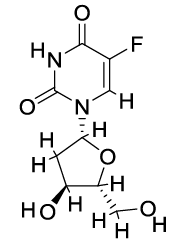 |
5.85 7.99 2.35 3.62 3.82 3.93 5.33 7.95 2.10 |
5.89-5.82 8.01-7.97 2.39-2.31 3.66-3.58 3.88-3.75 3.96-3.90 5.35-5.31 7.97-7.93 2.14-2.06 |
2.00 1.01 1.97 2.00 3.96 1.97 2.03 1.02 2.05 |
7.51,7.51 2.75,7.50,12.45 6.96,12.26 0.96,6.87,7.02 2.74,7.49,12.45 |
t s ddd dd m td s s ddd |
| 2-phenylacetate | 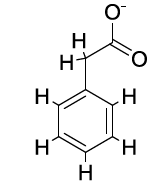 |
7.61 7.25 3.57 |
7.64-7.58 7.31-7.18 3.59-3.55 |
0.85 1.25 0.90 |
m m s |
|
| 2-phenylacetic acid | 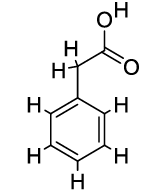 |
7.25 3.49 |
7.31-7.18 3.51-3.47 |
2.11 0.89 |
m s |
|
| (2S)-2-amino-N-[(2S,3S,4R, 5R)-5-[6-(dimethylamino)purin-9-yl]-4-hydroxy-2-(hydroxymethyl)oxolan-3- yl]-3-(4-methoxyphenyl)propanamide (Puromycin) |
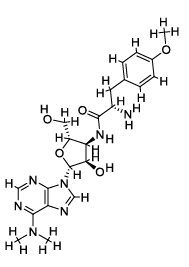 |
7.20 8.46 3.17 3.25 3.38 3.83 4.11 4.31 5.12 5.95 6.80 6.92 7.04 8.30 2.61 |
7.23-7.17 8.48-8.44 3.21-3.14 3.29-3.21 3.40-3.36 3.92-3.77 4.14-4.08 4.35-4.26 5.16-5.09 5.98-5.92 6.83-6.77 6.94-6.90 7.06-7.02 8.32-8.28 2.63-2.59 |
1.98 1.00 0.99 0.99 5.99 5.97 1.01 1.99 1.02 1.01 2.00 1.00 2.04 1.00 1.00 |
3.20,12.36 3.11,12.45 3.21,3.21 5.46,7.53 7.69 |
m s dd dd s m t m dd d m s s s s |
| 5-fluoro-1-(oxolan-2-yl)pyrimidine-2,4-dione (Tegafur) |
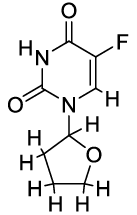 |
5.85 7.99 1.74 1.94 2.19 3.84 7.95 1.54 |
5.88-5.82 8.01-7.97 1.80-1.68 1.99-1.89 2.24-2.14 3.92-3.76 7.97-7.93 1.60-1.49 |
2.01 1.01 1.98 2.01 1.99 4.04 1.02 1.93 |
6.50,6.50
5.91,5.91,7.29,7.29,12.02 6.35,7.34,7.42,12.36 6.37,7.35,7.27,12.23 |
t s dtt dtd dtd m s m |
| 4-amino-7-[(2S,3R,4S,5R)-3, 4-dihydroxy-5-(hydroxymethyl)oxolan-2-yl]pyrrolo[2, 3-d]pyrimidine-5-carbonitrile (Toyocamycin) |
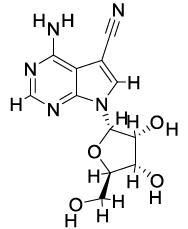 |
6.41 8.60 2.96 3.63 3.75 4.17 4.28 4.76 5.33 7.49 2.55 |
6.43-6.39 8.62-8.58 2.98-2.94 3.67-3.59 3.79-3.71 4.20-4.14 4.32-4.24 4.79-4.73 5.35-5.31 7.51-7.47 2.57-2.53 |
0.98 1.01 2.02 0.98 1.00 1.00 1.01 0.97 1.01 1.01 1.01 |
3.09 5.79,12.39 5.72,12.39 4.40,8.79 5.75,5.75,8.79 3.13,4.35 |
d s s dd dd dd dt dd s s s |
| 5-fluoro-1H-pyrimidine-2,4-dione (5-Fluorouracil) |
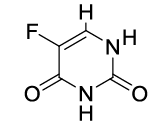 |
7.03 6.99 |
7.05-7.01 7.01-6.97 |
1.01 0.99 |
s s |
|
| 3,7-dihydropurine-6-thione (6-Mercaptopurine) |
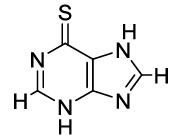 |
9.44 8.37 |
9.46-9.42 8.39-8.35 |
1.00 1.00 |
s s |
|
| 2-amino-3,7-dihydropurine-6-thione (6-Thioguanine) |
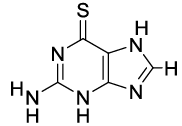 |
8.39 8.35 |
8.41-8.37 8.37-8.33 |
2.01 0.99 |
s s |
|
| 6-(3-methyl-5-nitroimidazol-4-yl)sulfanyl-7H-purine (Azathioprine) |
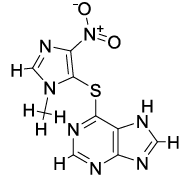 |
8.12 9.02 8.20 3.70 |
8.14-8.10 9.04-9.00 8.22-8.18 3.72-3.68 |
0.99 0.99 0.99 3.03 |
s s s s |
|
| pentyl N-[1-[(2R,3R,4S,5R)-3, 4-dihydroxy-5-methyloxolan-2-yl]-5-fluoro-2-oxopyrimidin-4-yl]carbamate (Capecitabine) |
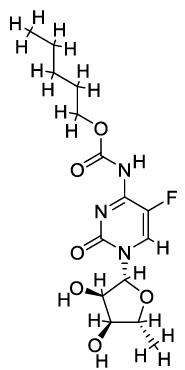 |
4.05 6.51 1.29 1.39 1.60 2.94 4.21 0.90 |
4.07-4.02 6.54-6.49 1.32-1.26 1.44-1.34 1.63-1.52 2.96-2.92 4.29-4.11 0.95-0.85 |
0.97 1.01 3.06 3.96 1.95 1.03 4.02 3.00 |
0.80,4.69 6.77 5.85 1.70,3.20,6.40, 6.40 |
dd d d tdd m s m m |
| 1-[(2R,3R,4S,5R)-3, 4-dihydroxy-5-methyloxolan-2-yl]-5-fluoropyrimidine-2,4-dione (Doxifluridine) |
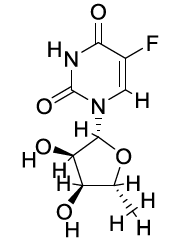 |
6.11 7.99 1.40 3.85 4.39 4.57 7.95 1.29 |
6.14-6.08 8.01-7.97 1.42-1.38 3.89-3.81 4.42-4.36 4.60-4.54 7.97-7.93 1.32-1.26 |
2.00 1.01 2.04 1.92 1.99 1.99 1.00 6.06 |
6.58 0.97,4.40 4.21,6.57 5.85 |
d s s m dd dd s d |
Table 1: The list of peaks, including the following information: Chemical shift (ppm, Hz), intensity (height), width (Hz), type (compound, solvent, impurity, etc.), flags, multiplicity (for the carbons) and annotations
Integration and multiplets analysis were done on the predicted peaks. Spectral integration can provide invaluable quantitative information about a molecule as the integral of a spectrum indicates the number of nuclei which contributes to a given line (or set of lines). In this study, 1H-NMR spectra software automatically determines the regions containing signals. Multiplets analysis provides information like chemical shift (ppm), range (ppm), number of hydrogen, integral value, type of multiplet and coupling constant values (Hz).
Results
There are 12 compounds of antineoplastic and anti-metabolites and J-coupling exists in 6 compounds. Out of 6 compounds, 5 compounds have pyrimidine ring in their structure. In multiplet analysis report, peaks belong to various classes. A peak is split by n identical protons into components whose sizes are in the ratio of the nth row of Pascal's triangle. Because the nth row has n+1 component, this type of splitting is said to follow the "n+1 rule": a proton with n neighbours appears as a cluster of n+1 peak. When a proton is coupled to two different protons, then the coupling constants are likely to be different, and instead of a triplet, a doublet of doublets will be seen. Similarly, if a proton is coupled to two other protons of one type, and a third of another type with a different, smaller coupling constant, then a triplet of doublets is seen. In six compounds, J-coupling has been detected for the doublet (d) or doublet of doublet (dd) or double of doublet (ddd) or triplet of doublet
• In the case of floxuridine, J-coupling has been detected at 5 different ppm ranges (5.89-5.82, 2.39-2.31, 3.66-3.58, 3.96-3.90, 2.14- 2.06) and all shifts (5.85, 2.35, 3.62, 3.93, 2.10) are due to hydrogen atoms of pyrimidine ring.
• In the case of puromycin, J-coupling has been detected at 5 different ppm ranges (3.21-3.14, 3.29-3.21, 4.14-4.08, 5.16-5.09, 5.98- 5.92) and out of 5 J-coupling, three shifts (5.95, 4.11, 5.12) are due to hydrogen atoms of pyrimidine ring.
• In the case of tegafur, J-coupling has been detected at 4 different ppm ranges (5.88-5.82, 1.80-1.68, 1.99-1.89, 2.24-2.14) and out of 4 coupling, all shifts (5.85, 1.74, 1.94, 2.19) are due to hydrogen atoms of pyrimidine ring.
• In the case of toyocamycin, J-coupling has been detected at 6 different ppm ranges (6.43-6.39, 3.67-3.59, 3.79-3.71, 4.20-4.14, 4.32- 4.24, 4.79-4.73) and out of 6 coupling, all shifts (6.41, 3.63, 3.75, 4.17, 4.28, 4.76) are due to hydrogen atoms of pyrimidine ring.
• In the case of capecitabine, J-coupling has been detected at 4 different ppm ranges (4.07-4.02, 6.54-6.49, 1.32-1.26, 1.44-1.34) and out of 4 coupling, all shifts (4.05, 6.51, 1.29, 1.39) are due to hydrogen atoms of pyrimidine ring.
• In the case of doxifluridine, J-coupling has been detected at 4 different ppm ranges (6.14-6.08, 4.42-4.36, 4.60-4.54, 1.32-1.26) and out of 4 coupling, all shifts (6.11, 4.39, 4.57, 1.29) are due to hydrogen atoms of pyrimidine ring.
Discussion
Pyrimidines heterocyclic moiety has great biological and medicinal significance. A large array of pyrimidine drugs possess a variety of medicinal properties. Pyrimidine nucleotides play critical roles in DNA and RNA synthesis as well as in membrane lipid biosynthesis and protein glycosylation. They are necessary for the development and survival of mature T lymphocytes. Activation of T lymphocytes is associated with an increase of pyrimidine pools [13]. Because of these properties, the pyrimidine ring is constituent of antineoplastic and antimetabolite drugs. Generally, antimetabolites induce cell death during the S phase of cell growth when incorporated into RNA and DNA or inhibit enzymes needed for nucleic acid production [14,15].
Antimetabolites of pyrimidine nucleotide metabolism specifically target enzymes that become hyperactive during neoplastic transformation may be potent differentiation inducers. Except for the DNA methylation perturbing agents, inhibition of DNA replication is common to all to the antimetabolites discussed. Presumably, inhibition of the proliferation program seems to represent the principal factor in the onset of antimetabolite-induced differentiation. Further, it is likely that the (deoxy) ribonucleotide pool imbalances, evoked by the anti-metabolites, play a crucial role in activating the differentiation program [16-18].
In this study, we presented the J-coupling of 12 anticancer drugs, many of which display potentially interesting biological activity and are routinely used in combination with other drugs for the treatment of various types of cancer. This study describes the application of advanced 1HNMR technique for the characterization of anticancer drugs with pyrimidine ring. Further work in the direction of characterizing the crosslinking of these drugs with their targets using NMR spectroscopy, is in progress in our laboratory.
Conclusion
From the total of 12 antineoplastic and antimetabolite drugs, J-coupling is present in 6 compounds. The pyrimidine ring exists in 5 out of these compounds. The presence of pyrimidine ring is resulting in J-coupling and both conditions are pre-requisite for the development of anti-cancer drugs.
Acknowledgement
This study was supported by Department of Biotechnology, Sharda University and Scube Scientific Software Solutions, New Delhi.
References
- R. Gruetter, S.A. Weisdorf, V. Rajanayagan, M. Terpstra, H. Merkle, C.L. Truwit, J. Magn. Reson., 1998, 135, 260-264.
- D.A. Torchia, eMag. Res., 2012.
- E.L. Hahn, D.E. Maxwell, Phys. Rev., 1952, 88(5), 1070-1084.
- A.J. Dingley, F. Cordier, S. Grzesiek, Concepts in Magnetic Resonance., 2001, 13(2), 103-127.
- http://www.ncbi.nlm.nih.gov/mesh?term=Antineoplastic%20Agents.
- S. Nussbaumer, P. Bonnabry, J.L. Veuthey, S.F. Souverain, Talanta., 2011, 85, 2265-2289.
- D.T. Ross, U. Scherf, M.B. Eisen, C.M. Perou, C. Rees, P. Spellman, Nat Genet., 2000, 24(3), 227-235.
- G.J. Peters, C.L. van der Wilt, C.J. van Moorsel, J.R. Kroep, A.M. Bergman, S.P. Ackland, Pharmacol. Ther., 2000, 87(2-3), 227-253.
- L. Lennard, J.S. Lilleyman, J. Van Loon, R.M. Weinshilboum, Lancet., 1990, 336(8709), 225-229.
- J.M. Carethers, E.J. Smith, C.A. Behling, L. Nguyen, A. Tajima, R.T. Doctolero, Gastroenterology., 2004, 126(2), 394-401.
- H.A. Burris, M.J. Moore, J. Andersen, M.R. Green, M.L. Rothenberg, M.R. Modiano, J. Clin. Oncol., 1997, 15(6), 2403-2413.
- Cobas C. MestRe Nova. 8.1.1 ed; Mnova software package, Mestrelab, Inc., 2011.
- L. Quéméneur, L.M. Gerland, M. Flacher, M. Ffrench, J.P. Revillard, L. Genestier, J. Immunol. 2003, 170(10), 4986-4995.
- T. Nakamura, T. Uchida, M. Ueda, Gan To Kagaku Ryoho., 1992, 19(2), 265-276.
- T. Nakamura, T. Ueda, M. Uchida, Gan To Kagaku Ryoho., 1992, 19(3), 4094-4120.
- S. Hatse, E. De Clercq, J. Balzarini, Biochem Pharmacol., 1999, 58(4), 539-555.
- J.F. Henderson, J.K. Lowe, J. Barankiewicz, Ciba Found Symp., 1977, 48, 3-21.
- C.M. Galmarini, J.R. Mackey, C. Dumontet, Lancet Oncol., 2002, 3(7), 415-424.



